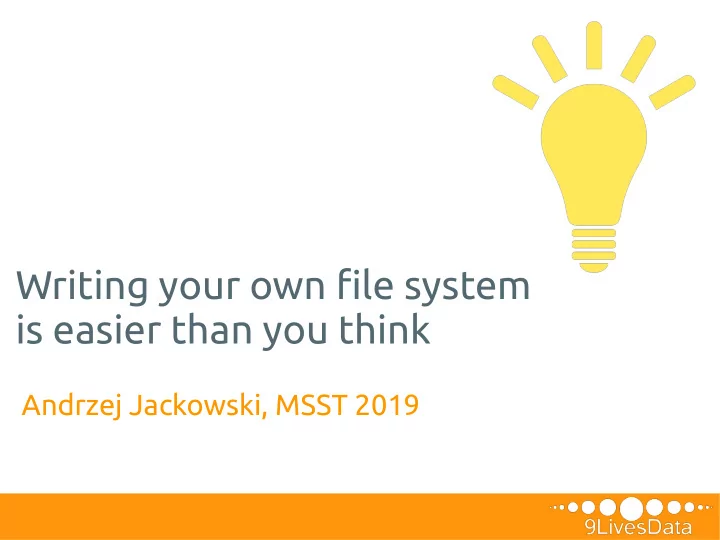

Writing your own fjle system is easier than you think Andrzej Jackowski, MSST 2019
- I’ve been working for 9LivesData since 2014 > Advanced software R&D since 2008 > 75 developers / scientist with MSc/Phd in CS > Clients in the USA and Japan > Millions of C/C++ LOCs > Products used by thousands of corporations worldwide > Specializations: fjle systems, software defjned storage, scalable distributed systems, deduplication - I’m also a PhD student at University of Warsaw 2 2
- In 9LD, one of our projects is a backend of HYDRAstor > distributed secondary storage > global deduplication > massive linear scalability from 1 to 165 nodes > capacity up to 11.88PB (158.4PB efgective) > high performance (up to 5.2PB / hr) > erasure-coding, self-healing > 5 th generation on the market > Veritas NetBackup™ OpenStorage integration > deduplication client fs - More details available in our publications >“HYDRAstor – A Scalable Secondary Storage“ The 7th USENIX Conference on File and Storage Technologies (FAST ’09) San Francisco, California, USA, February 2009 > “A High-Throughput File System for the HYDRAstor Content-Addressable Storage System” The 8th USENIX Conference on File and Storage Technologies (FAST ’10), San Jose, California, USA, February 2010 > “Concurrent Deletion in a Distributed Content-Addressable Storage System with Global Deduplication“ 11th USENIX Conference on File and Storage Technologies (FAST ’13) San Jose, California, USA, February 2013 3 3
Why we needed a custom fjle system? - We needed a fjle system in the deepest level of HYDRAstor - We started with ext3 – most common fs at that time - Very high fragmentation, even if disk wasn’t full - Out of space protection was very tricky E.g. statfs show num of blocks, but a single block append can use 1-4 blocks; directory size changes on fjle creation - Double journaling afgected performance We needed own journal to perform transactions on multiple disks 4 4
There were a lot of difgerent problems - Many others performance issues > Ineffjcient fsync / O_SYNC > Inode lock (only one outstanding operation on each inode) > io_submit blocked thread sometimes > Needless features afgecting critical path (e.g. small fjles support; directories) - General lack of control > Diffjcult integration with our resource manager > We needed to develop custom features (e.g. on-demand shredding of data) 5 5
We kept design of our fs as simple as possible - Only two data structures (and two superblocks + optional label) > free map – keeps information about unused disk blocks > inode table – keeps simplifjed inodes, we don’t even need fjlenames Disk layout of our file system - Allocation algorithm that solved fragmentation issue 1. Find the closest extent after the current “allocation pointer” of size at least 1024 blocks, within initial disk part of size = total occupied space * 120%. 2. If it fails, try the same within the whole partition. 3. Then seek the closest free extent within the whole partition, of minimal size 256 blocks, then 32 block and fjnally 1 block. 4. Once you’ve found some extent, remember to update the allocation pointer to its end. 6 6
FreeMap design Inode table design Logarithmic search for the closest next group with a given minimum free extent size Inode table design Explained with details by High-level design of Free map Marian Kędzierski in a blog post: http://9livesdata.com/writing-your-own-file-system-is-easier-than-you-think/ 7 7
Performance evaluation Write throughput during difgerent loads 2x – 4x improvement Write throughput - Our fjlesystem - EXT3 Time 8 8
The After Years - Our fjle system is easy to develop, understand and maintain Man-hours spent on creating fjle system from scratch paid ofg - Performance is great, but now the gap is smaller Especially XFS caught up in our recent benchmarks - Ceph adopted similar strategy by introducing BlueStore 9 9
Takeaway Sometimes it is easier to implement dedicated solution from scratch than adjust a complex general-purpose code 10 10
Thanks for watching! A n y f e e d b a c k i s a p p r e c i a t e d ! ! ! jackowski@9livesdata.com Visit our blog for more details linkedin.com/in/ajackowski/ www.9livesdata.com/blog/ 11 11
Recommend
More recommend